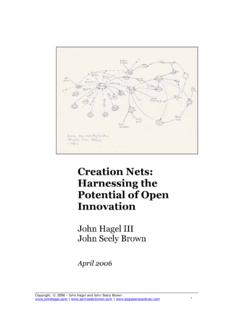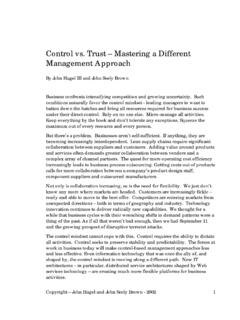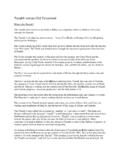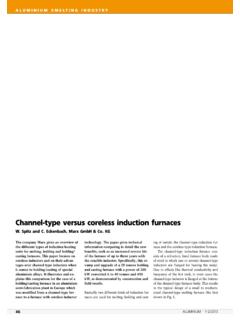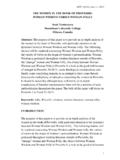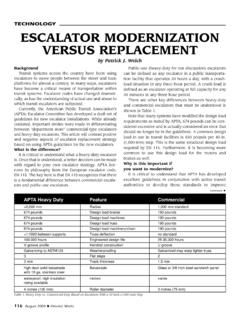Transcription of From Push to Pull- - John Hagel
1 from push to pull - Emerging Models for Mobilizing Resources John Hagel & John Seely Brown Working Paper, October 2005 This working paper represents the beginning of a major new wave of research that will lead eventually to a new book. The perspectives presented here build upon the work covered in our most recent book, The Only Sustainable Edge: Why Business Strategy Depends on Productive Friction and Dynamic Specialization. If you have not yet had a chance to buy and read this book, we urge you to do so, since it will help you to get a lot more out of this new material. The Only Sustainable Edge explores some of the dynamics unfolding at the edge of the firm and at the edge of markets (especially focusing on the role of emerging markets like China and India). But this is only a part of a much broader research agenda that we will be pursuing in the months and years ahead.
2 Our point of view is simply stated: the edge is becoming the What do we mean by this? The edge is where the action is - in terms of growth, innovation and value creation. Companies, workgroups and individuals that master the edge will build a more sustainable core. While our primary focus will be on business activity, our perspectives will also be relevant to leaders of other kinds of institutions as well - educational, governmental and social. The edge is giving rise to a new common sense model. We all perceive and act based on "common sense" assumptions about the world around us and the requirements to achieve our goals. Every major technology shift has produced a fundamentally new common sense model. Our goal is to understand and describe key elements of the new common sense model emerging from technology innovations - especially the invention of the microprocessor and the introduction of packet-switched networks - that were introduced in the early to mid-1970s.
3 This working paper takes you further down our path of exploration. John Hagel John Seely Brown October 2005 Sign up for updates at Copyright 2005 John Hagel and John Seely Brown | | 2 Copyright 2005 John Hagel and John Seely Brown | | 3 The signs are around us. We are on the cusp of a shift to a new common sense model that will re-shape many facets of our life, including how we identify ourselves, participate with others, connect with others, mobilize resources and learn. This paper will focus on only one facet of this new common sense model emerging approaches for mobilizing resources. Over the past century, we have been perfecting highly efficient approaches to mobilizing resources. These approaches may vary in their details, but they share a common foundation. They are all designed to push resources in advance to areas of highest anticipated need.
4 In education, we design standard curricula to expose students to codified information in a pre-determined sequence of experiences. In business, we build highly automated plants or service platforms supported by standardized processes seeking to deliver resources to the right place at pre-determined times. In technology, we write massive enterprise applications specifying activities that must be performed and resources that must be deployed to meet anticipated demand. In the past decade, we have seen early signs of a new model for mobilizing resources. Rather than push , this new approach focuses on pull creating platforms that help people to mobilize appropriate resources when the need arises. In lean manufacturing, early elements of a pull model began to emerge from Toyota in the early 1950 s. As we will discuss below, however, lean manufacturing represents a hybrid between push and pull models it still contains significant elements of push models.
5 More fully developed pull models would take several more decades to emerge in arenas as diverse as media and advertising, global process networks and education. These are not just isolated examples - powerful forces are at work Copyright 2005 John Hagel and John Seely Brown | | 4 shaping the need for an alternative approach to mobilizing resources. These forces ensure that this new model will spread to all arenas of human activity. pull models are emerging as a response to growing uncertainty. Instead of dealing with uncertainty through tighter control, pull models do the opposite. They seek to expand the opportunity for creativity by local participants dealing with immediate needs. To exploit the opportunities created by uncertainty, pull models help people to come together and innovate in response to unanticipated events, drawing upon a growing array of highly specialized and distributed resources.
6 Rather than seeking to constrain the resources available to people, pull models strive to continually expand the choices available while at the same time helping people to find the resources that are most relevant to them. Rather than seeking to dictate the actions that people must take, pull models seek to provide people on the periphery with the tools and resources (including connections to other people) required to take initiative and creatively address opportunities as they arise. push models treat people as passive consumers (even when they are producers like workers on an assembly line) whose needs can be anticipated and shaped by centralized decision-makers. pull models treat people as networked creators (even when they are customers purchasing goods and services) who are uniquely positioned to transform uncertainty from a problem into an opportunity.
7 pull models are ultimately designed to accelerate capability building by participants, helping them to learn as well as innovate, by pursuing trajectories of learning that are tailored to their specific needs. By mastering the techniques required to make this new model work, companies will be well-positioned to create substantial economic value. Those who adhere rigidly to the old model will likely destroy significant economic value. Copyright 2005 John Hagel and John Seely Brown | | 5 Early Signs of the New Model As William Gibson reminds us, the future is already here, it is just unevenly distributed . We are beginning to see early signs of new models for resource mobilization in diverse arenas, from media to global process networks to education. Even within these arenas, however, the new models are still operating in very early form at the peripheries of more mature push models often, as in education, they are emerging under the radar, in areas that we would not first think to look.
8 Media Over the past decade, we have witnessed a transformation of the media landscape. On the one hand, mass media is becoming more concentrated in terms of ownership as audiences and revenue sources slowly decline. On the other hand, we are witnessing a blossoming of niche content, aided by four converging developments: the development of low cost and easily accessible content creation tools, the spread of the Internet as an infrastructure for content distribution, the growth of new forms of access devices and the emergence of new types of distribution businesses facilitating the transition to pull models of content distribution. Anything that can be digitized can be accessed and distributed on the Internet. As bandwidth has increased and compression algorithms have improved, we have seen a migration from text-based content to music and now to video in terms of using the Internet as a platform for access and distribution.
9 At the same time more powerful, compact and mobile access devices like MP3 players and digital video recorders like Tivo are making it easier to find and connect with relevant content. Copyright 2005 John Hagel and John Seely Brown | | 6 Rather than waiting for media companies to deliver relevant content at appropriate times, customers are increasingly reaching out to pull content to them when they want. They are aided in this task by new distribution businesses that are breaking down the shelf space constraints of traditional distribution channels, radically expanding the range of content that is available and providing robust tools to help customers find the content that is most relevant to them. Sometimes these new businesses look like more conventional retailers in the sense of providing a single point of access to broad assortments of media ( , Amazon or Netflix).
10 Sometimes they provide new ways of sampling media before buying ( , Rhapsody). But others are quite different, ranging from eBay where the closest analogue is the local flea market to peer to peer networks that lack any central hub at all and enable owners of content to pull from each other directly. But the changes to the media business are not restricted to distribution pull approaches are also emerging in media production, leading to a further proliferation in media choices. At the most basic level, younger generations of customers are increasingly customizing media to better suit their individual needs. For example, rather than relying on music companies to pre-determine the mix of songs on a CD, an increasing number of music listeners are downloading individual tracks and assembling their own tailored sequence of songs.
